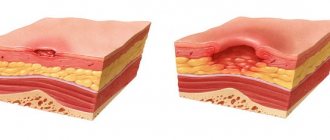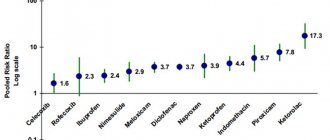Instructions for use
Pilobact AM is a combination drug that is used to treat duodenal ulcers caused by Helicobacter pylori.
Advantages of the medicinal complex:
- high level of eradication (destruction) of the pathogen - up to 97%;
- short course - only 7 days;
- one package is designed for the entire course of treatment;
- few side effects;
- convenient packaging, eliminating overdose, even if the patient is forgetful.
Indications for use
The main pathologies in the treatment of which the drug Pilobact is effective:
ulcers of the stomach and duodenum (during exacerbations or in remission);- atrophic form of gastritis;
- MALT lymphoma;
- postoperative condition after resection (removal of part of an organ) for stomach cancer;
- first-degree relatives of patients with gastric cancer.
Relative indications for which the medicine is prescribed:
- functional dyspepsia;
- gastropathy resulting from taking non-steroidal anti-inflammatory drugs;
- GERD, or gastroesophageal reflux disease.
Release form, composition
Pilobact AM is available in capsule form. The composition of the medicinal complex includes the following drugs:
enteric capsule omeprazole (0.02 g)—2 pcs.;- clarithromycin film-coated tablet (0.5 g) - 2 pcs.;
- amoxicillin capsule (amoxicillin trihydrate - 0.5 g) - 4 pcs.;
- All tablets and capsules are contained in 1 strip, a total of 7 strips in a pack.
The active ingredients produce the following effects:
- omeprazole - inhibits the production of gastric juice, reduces basal and stimulated secretion, acts within an hour after administration, the maximum concentration is observed after 2 hours, the maximum period of action is 24 hours;
- Clarithromycin is a macrolide antibiotic of semi-synthetic origin, a derivative of erythromycin A, acts on bacteria and inhibits protein synthesis, and is characterized by a wide spectrum of action;
- amoxicillin is also a semisynthetic antibiotic made from penicillins, effective against many pathogenic microorganisms.
Clarithromycin and amoxicillin in this combination enhance each other's effect.
Mode of application
Each strip contains a daily dose of medication, which is convenient for the patient, and is divided into two colored zones - morning and evening.
Take in the morning and evening:
- omeprazole and clarithromycin - 1 tablet each;
- amoxicillin - 2 tablets.
Capsules are not opened and tablets are not crushed, as this reduces the effectiveness of the drug.
Interaction with other drugs
The active ingredients of the complex react with some medications. The following combinations are undesirable:
- with theophylline - clarithromycin increases the concentration;
- with terfenadine - the concentration is increased by clarithromycin, which may prolong the QT interval;
- with indirect coagulants - the effect is potentiated by clarithromycin;
- with carbamazepine, cyclosporine, phenytoin, lovastatin, valproate, digoxin, astemizole, disopyramide, cisapride - clarithromycin increases the concentration;
- with phenytoin, warfarin, diazepam - concentration increases with omeprazole;
- with ketoconazole, ketoconazole, iron salts, ampicillin - affects the absorption of omeprazole;
- with oral contraceptives - reduces the effectiveness of amoxicillin.
Pilobact AM can cause adverse events, about which the doctor warns the patient before starting treatment. There are also some contraindications.
Pilobact and Pilobact AM
Pilobact
(lat.
pylobact
) and
Pilobact ® AM
(lat.
pylobact ® AM
) are combination drugs intended for the treatment of duodenal ulcer associated with
Helicobacter pylori
. According to ATC, both drugs belong to group “A02B. Antiulcer drugs and drugs for the treatment of gastroesophageal reflux”, subgroup “A02BD Combinations of drugs for the eradication of Helicobacter pylori”. The combined active ingredient Pilobact AM - omeprazole + amoxicillin + clarithromycin has a separate code A02BD05. The combined active ingredient of Pilobact is omeprazole + tinidazole + clarithromycin.
Composition of Pilobact AM
Pilobact AM is a set of tablets and capsules:
- enteric capsule containing 20 mg omeprazole
- film-coated tablet containing 500 mg clarithromycin
- capsule containing 500 mg amoxicillin (as trihydrate)
Omeprazole is a proton pump inhibitor that reduces the acidity of gastric juice, ATC code A02BC01.
Clarithromycin is a semisynthetic antibiotic from the macrolide group, ATC code J01FA09. Amoxicillin is a semisynthetic antibiotic from the group of broad-spectrum penicillins, ATC code J01CA04. One set of Pilobact AM corresponds to the daily dose and contains:
- 2 capsules omeprazole 20 mg
- 2 tablets of clarithromycin 500 mg
- 4 capsules amoxicillin 500 mg.
Composition of Pilobact
Pilobact differs from Pilobact AM in that instead of 4 amoxicillin capsules it contains 2 tablets containing 500 mg of tinidazole each. One set of Pilobact corresponds to the daily dose and contains:
- 2 capsules omeprazole 20 mg
- 2 tablets of clarithromycin 500 mg
- 2 tablets of tinidazole 500 mg.
Tinidazole is a synthetic antibacterial agent, ATC code J01XD02.
Indications for use of Pilobact AM and Pilobact
Eradication therapy of Helicobacter pylori
for duodenal ulcer.
Method of use of Pilobact and Pilobact AM and dose
The tablets and capsules included in the Pilobact and Pilobact AM kits are swallowed whole and should not be broken or chewed.
Each kit is intended to be taken within one day. Half in the morning, half in the evening. Tablets and capsules are taken before meals with water. When treating with Pilobact AM, take the following included in the kit at a time: one capsule of omeprazole, one tablet of clarithromine and two capsules of amoxicillin.
When treating with Pilobact, take the following included in the kit at a time: one capsule of omeprazole, one tablet of clarithromine and one tablet of tinidazole.
The duration of the eradication course is one week (seven days).
Professional medical articles concerning the use of Pilobact and Pilobact AM in the treatment of gastrointestinal diseases
- Minushkin O.N., Zverkov I.V., Volodin D.V., Ivanova O.I., Shuleshova A.G. The effectiveness of the drug "Pilobact AM" in eradication therapy of duodenal ulcer // Doctor. – No. 5. – 2008.
- Maev I.V., Samsonov A.A., Andreev D.N., Kochetov S.A., Andreev N.G., Dicheva D.T. Modern aspects of diagnosis and treatment of Helicobacter pylori infection // Medical Council. 2012. No. 8. pp. 10–19.
On the website in the literature catalog there is a section “Helicobacter pylori”, containing articles devoted to gastrointestinal diseases associated with Helicobacter pylori
.
Pharmacological properties of Pilobact and Pilobact AM
Triple therapy, including omeprazole, clarithromycin and amoxicillin (or tinidazole), can achieve a high percentage of Helicobacter pylori
(85-94%). Omeprazole inhibits the secretion of gastric acid due to the specific inhibition of blocking the proton pump (H+/K+-ATPase, an enzyme located in the membranes of the parietal cells of the gastric mucosa. It reduces basal and stimulated secretion, regardless of the nature of the stimulus. After a single dose of the drug orally, the effect of omeprazole occurs during the first hour and continues for 24 hours, the maximum effect is achieved after 2 hours.After stopping the drug, secretory activity is completely restored after 3-5 days.
Amoxicillin is a semi-synthetic penicillin, a broad-spectrum antibiotic due to inhibition of peptidoglycan synthesis during division and growth. Has pronounced activity against Helicobacter pylori
.
Helicobacter pylori
resistance to amoxicillin is rare.
Tinidazole is a synthetic drug whose antimicrobial effect is associated with inhibition of synthesis and disruption of the DNA structure of sensitive microorganisms.
Clarithromycin is an antibiotic from the macrolide group, a semi-synthetic derivative of erythromycin A. It has an antimicrobial effect, which is associated with the suppression of protein synthesis by interaction with the 50S ribosomal subunit of the microbial cell. Effective against a large number of gram-positive, gram-negative aerobic and anaerobic microorganisms, including Helicobacter pylori
.
The metabolite 14-hydroxyclarithromycin formed in the body also has pronounced antimicrobial activity. Combinations of clarithromycin with amoxicillin or tinidazole have a potent antimicrobial effect against Helicobacter pylori
.
Manufacturer of Pilobact and Pilobact AM
— Ranbaxy Laboratories Ltd., India.
Pilobact and Pilobact AM have contraindications, side effects and application features; consultation with a specialist is necessary. Back to section
Side effects
The following side effects should be expected from Pilobact AM:
- from the gastrointestinal tract : stomatitis, dry mouth, taste disturbance, vomiting, nausea, dysbacteriosis, stool disorders, impaired liver function and increased activity of enzymes of this organ;
- from the musculoskeletal system : weakness and muscle pain, arthralgia (joint pain);
- circulatory system : changes in the blood formula - leukopenia, neutropenia, thrombocytopenia (decrease in the level of leukocytes, neutrophilic leukocytes, platelets, respectively), thrombocytopenic purpura (Wergolf's disease) - a primary hemorrhagic diathesis caused by a deficiency of the platelet component;
- nervous system : headache, confusion, epileptic seizures, drowsiness, hallucinations, depression, ataxia (impaired coordination of movements), agitation, paresthesia (impaired skin sensitivity);
- possible allergic reactions - angioedema, bronchospasm, urticaria, anaphylactic shock;
- other side effects - visual impairment, tachycardia (heart rhythm disturbance), abnormal sweating, in men - gynecomastia (enlarged mammary glands), increased body temperature, interstitial nephritis, peripheral edema.
Contraindications
Pilobact AM is not used for the treatment of persons with the following diseases:
- intolerance to any component of the drug;
- porphyria is a hereditary disease associated with a disorder of pigment metabolism and a high concentration of porphyrins in the blood;
- insufficient liver or kidney function.
The complex is contraindicated in children.
During pregnancy and breastfeeding
Pilobact AM is prohibited for use by women during pregnancy and breastfeeding . If there is a need to use the medicine during lactation, then breastfeeding is interrupted.
Pilobact®
Clarithromycin
When used simultaneously with astemizole, cisapride, pimozide, terfenadine, an increase in the concentration of the latter in the blood was reported, which can lead to cardiac arrhythmias (prolongation of the QT interval on the electrocardiogram, ventricular tachycardia, ventricular fibrillation, torsade de pointes). Concomitant use of clarithromycin with astemizole. cisapride, pimozide, terfenadine are contraindicated.
The simultaneous use of clarithromycin and ergotamine or dihydroergotamine (ergot alkaloids) can lead to acute ergotamine intoxication, accompanied by severe peripheral vasospasm (impaired sensitivity, paresthesia, pain and a marked decrease in pulsation in the extremities, disorders of the central nervous system - dizziness, convulsions, coma). Concomitant use of clarithromycin with ergot alkaloids is contraindicated. Caution should be exercised when using clarithromycin concomitantly with ototoxic drugs, primarily aminoglycosides, due to increased ototoxicity. During and after treatment, the function of the hearing organ and vestibular apparatus should be monitored. Concomitant use of zidovudine in HIV-infected adult patients may result in decreased steady-state zidovudine concentrations. Since clarithromycin affects the absorption of concomitantly administered oral zidovudine, it is recommended that these drugs be taken at least 4 hours apart.
Concomitant use of clarithromycin and digoxin
Digoxin is suspected to be a Pgp substrate. Clarithromycin is known to inhibit Pgp. When clarithromycin and digoxin are used together, inhibition of Pgp by clarithromycin may result in increased effects of digoxin. Post-marketing studies have shown that coadministration of digoxin and clarithromycin may also result in increased serum concentrations of digoxin. Some patients have experienced clinical symptoms of digoxin toxicity, including potentially fatal arrhythmias. Serum digoxin concentrations should be carefully monitored when clarithromycin and digoxin are coadministered.
Interactions caused by
CYP3A CYP3A4
isoenzyme (for example, rifampicin, phenytoin, carbamazepine, phenobarbital, St. John's wort) can induce the metabolism of clarithromycin . This may result in subtherapeutic concentrations of clarithromycin, resulting in reduced effectiveness. In addition, it is necessary to monitor the concentration of the CYP3A isoenzyme inducer in the blood plasma, which may increase due to the inhibition of the CYP3A isoenzyme by clarithromycin. The following drugs have a proven or suspected effect on clarithromycin plasma concentrations; if they are used together, dosage adjustments or switching to alternative treatment may be necessary.
Efavirenz, nevirapine, rifampicin, rifabutin, rifapentine increase the metabolism of clarithromycin, reducing its concentration in the blood plasma and increasing the concentration of its biologically active metabolite 14-hydroxyclarithromycin. In patients receiving inducers of CYP3A isoenzymes, alternative antibiotic therapy options should be considered. The simultaneous use of clarithromycin and rifabutin leads to an increase in the concentration of rifabutin and a decrease in the concentration of clarithromycin in the blood plasma with the risk of developing uveitis.
The concentration of clarithromycin decreases with the use of etravirine, but the concentration of the active metabolite 14-hydroxyclarithromycin increases. Because 14-hydroxyclarithromycin has little activity against Mycobacterium avium complex (MAC) infections, overall activity against Mycobacterium avium complex (MAC) infections may vary and alternative treatments should be considered for the treatment of MAC.
The simultaneous use of fluconazole leads to an increase in the steady-state concentration and area under the curve of “conconcurrent” ventricular tachycardia. Monitoring of ECG (increased QT interval) and serum concentrations of these drugs is necessary. Cases of hypoglycemia have been reported with the combined use of clarithromycin and disopyramide. It is necessary to monitor the concentration of glucose in the blood plasma when using these drugs simultaneously.
Concomitant use with HMG-CoA reductase inhibitors (simvastatin, lovastatin) leads to an increased risk of developing myopathy and rhabdomyolysis. Concomitant use of clarithromycin with simvastatin and lovastatin is contraindicated. Clarithromycin should be used with caution in combination therapy with other statins. If co-administration with statins is necessary, it is necessary to use statins that do not depend on CYP3A metabolism (for example, fluvastatin). It is recommended to take the lowest dose of statin. The development of signs and symptoms of myopathy should be monitored.
When using clarithromycin simultaneously with blockers of “slow” calcium channels that are metabolized by the CYP3A4 isoenzyme (for example, verapamil, amlodipine, diltiazem), caution should be exercised, as there is a risk of arterial hypotension and bradyarrhythmia. Plasma concentrations of clarithromycin, as well as slow calcium channel blockers, may increase with simultaneous use. Arterial hypotension, bradyarrhythmia and lactic acidosis are possible when taking clarithromycin and verapamil simultaneously.
Colchicine is a substrate for both CYP3A and P-glycoprotein, which are inhibited by clarithromycin. A single dose of 0.6 mg colchicine combined with clarithromycin 250 mg twice daily for a week resulted in a 197% increase in the maximum concentration of colchicine and the area under the conconconcontraindications curve. Omeprazole has been shown to interact with some antiretroviral drugs. The mechanisms and clinical significance of these interactions are not always known. An increase in pH during omeprazole therapy may affect the absorption of antiretroviral drugs. Interaction at the level of the CYP2C19 isoenzyme is also possible. When omeprazole is co-administered with certain antiretroviral drugs, such as atazanavir and nelfinavir, a decrease in their serum concentrations is observed during omeprazole therapy. In this regard, the combined use of omeprazole with antiretroviral drugs such as atazanavir and nelfinavir is not recommended.
With the simultaneous use of omeprazole and saquinavir, an increase in the concentration of saquinavir in the serum was noted; when used with some other antiretroviral drugs, their concentration did not change.
Omeprazole inhibits CYP2C19, the main isoenzyme involved in its metabolism. Concomitant use of omeprazole with other drugs metabolized by the CYP2C19 isoenzyme, such as diazepam, warfarin (R-warfarin) or other vitamin K antagonists phenytoin and cilostazol, may lead to a slower metabolism of these drugs. Monitoring of patients taking phenytoin and omeprazole is recommended; a dose reduction of phenytoin may be required. However, concomitant treatment with omeprazole at a daily dose of 20 mg does not affect the concentration of phenytoin in the blood plasma in patients taking the drug for a long time. When using omeprazole in patients receiving warfarin or other vitamin K antagonists, monitoring of the international normalized ratio is necessary; in some cases, it may be necessary to reduce the dose of warfarin or another vitamin K antagonist. At the same time, concomitant treatment with omeprazole at a daily dose of 20 mg does not lead to a change in coagulation time in patients taking warfarin for a long time.
The use of omeprazole at a dose of 40 mg once daily resulted in an increase in Cmax and AUC of cilostazol by 18% and 26%, respectively; for one of the active metabolites of cilostazol, the increase was 29% and 69%, respectively.
According to the study results, a pharmacokinetic/pharmacodynamic interaction was noted between clopidogrel (loading dose of 300 mg and maintenance dose of 75 mg/day) and omeprazole (80 mg/day orally), which leads to a decrease in exposure to the active metabolite of clopidogrel by an average of 46 % and reducing the maximum inhibition of ADP-induced platelet aggregation by an average of 16%.
The clinical significance of this interaction is unclear. An increased risk of cardiovascular events with concomitant use of clopidogrel and proton pump inhibitors, including omeprazole, was not shown in a prospective, randomized, open-label study of more than 3,760 patients receiving placebo or omeprazole 20 mg/day. concomitantly with clopidogrel and acetylsalicylic acid (ASA) therapy, and was not confirmed by additional non-randomized analysis of clinical outcomes from large prospective randomized trials involving more than 47,000 patients.
The results of a number of observational studies are contradictory and do not provide a clear answer about the presence or absence of an increased risk of thromboembolic cardiovascular complications during the combined use of clopidogrel and proton pump inhibitors.
When clopidogrel was used together with a fixed combination of 20 mg esomeprazole and 81 mg ASA, exposure to the active metabolite of clopidogrel decreased by almost 40% compared with clopidogrel monotherapy, while the maximum levels of inhibition of ADP-induced platelet aggregation were the same, which is likely due to simultaneous taking ASA in a low dose.
Omeprazole does not affect the metabolism of drugs metabolized by the CYP3A4 isoenzyme. such as cyclosporine, lidocaine, quinidine, estradiol, erythromycin and budesonide.
No interaction of omeprazole with the following drugs has been identified: antacids, caffeine, theophylline, S-warfarin, piroxicam, diclofenac, naproxen, metoprolol, propranolol and ethanol.
With the simultaneous use of omeprazole and tacrolimus, an increase in the concentration of tacrolimus in the blood serum was noted.
Some patients experienced a slight increase in methotrexate concentrations when combined with proton pump inhibitors. If high doses of methotrexate are prescribed, temporary discontinuation of omeprazole should be considered.
Effect of drugs on the pharmacokinetics of omeprazole
The isoenzymes CYP2C19 and CYP3A4 are involved in the metabolism of omeprazole. Concomitant use of omeprazole and inhibitors of CYP2C19 and CYP3A4 isoenzymes. such as clarithromycin and voriconazole, may lead to increased plasma concentrations of omeprazole by slowing the metabolism of omeprazole. Concomitant use of voriconazole and omeprazole results in a more than twofold increase in the AUC of omeprazole. Due to the good tolerance of high doses of omeprazole, short-term joint use of these drugs does not require dose adjustment of omeprazole.
Co-administration of omeprazole with amoxicillin or metronidazole does not affect the concentration of omeprazole in the blood plasma.
Drugs that induce CYP2C19 and CYP3A4 isoenzymes. such as rifampicin and St. John's wort preparations, when used together with omeprazole, can lead to a decrease in the concentration of omeprazole in the blood plasma by accelerating the metabolism of omeprazole.
Tinidazole
Tinidazole enhances the effect of indirect anticoagulants and the effect of ethanol - disulfiram-like reactions are possible. Compatible with sulfonamides and antibiotics (aminoglycosides, erythromycin, rifampicin, cephalosporins). It is not recommended to administer together with ethionamide. Phenobarbital accelerates the metabolism of tinidazole.
Reviews
Patients complain of poor tolerability of the drug complex. Most common complaints:
- bitterness in the mouth;
- diarrhea;
- pain in different parts of the abdomen;
- weakness;
- dizziness.
Increased hair loss, rumbling in the stomach, and mood swings are also possible.
In view of the described side effects, those who have already been treated with Pilobact AM are advised to issue a sick leave certificate for the duration of the course of therapy.
Read detailed reviews at the end of the article.








